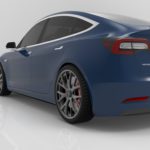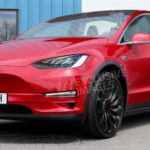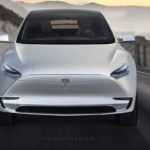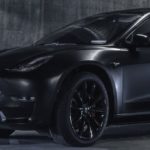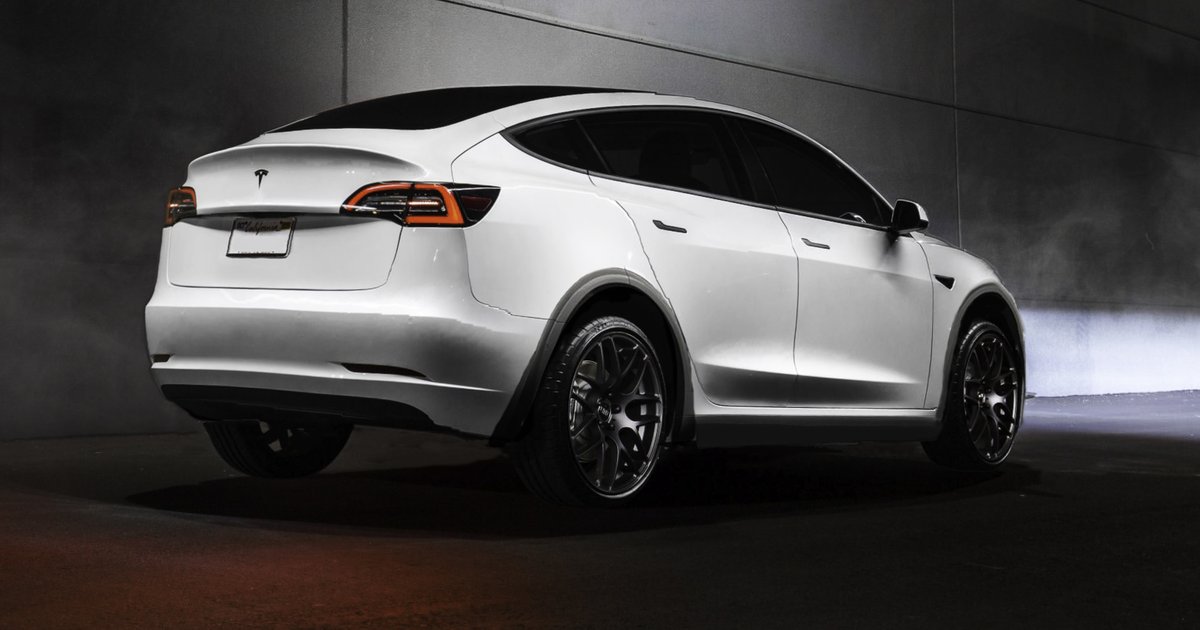
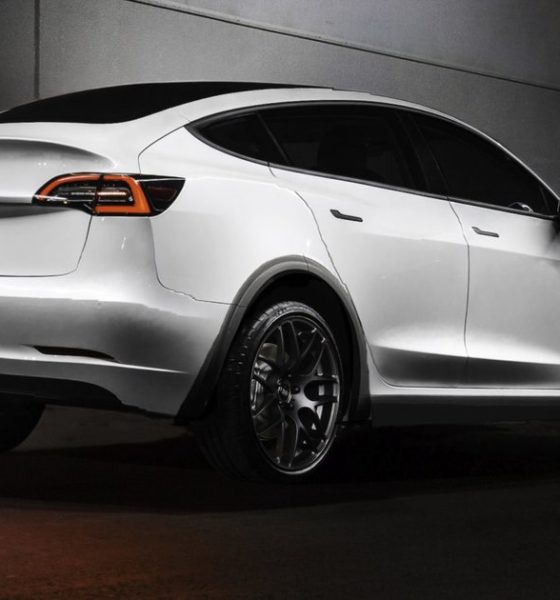
Investor's Corner
The Model Y represents a wiser Tesla and it should wake up the auto industry
It is now just a matter of time before Tesla unveils the next vehicle in its product roadmap — the Model Y. Aimed at the auto industry’s most lucrative segment today, the all-electric SUV and its potential success could definitively establish Tesla’s reputation as a successful carmaker. With this in mind, the Model Y’s 2019 release could be seen as a strategic move for Tesla, since the company is now at a point where it has matured enough to produce a vehicle of such magnitude and caliber as the all-electric SUV.
A competitive segment
The compact SUV segment in the United States is an incredibly competitive market. In 2018 alone, auto sales tracking website CarSalesBase noted that the Toyota Rav4 — the reigning king of compact SUVs — sold 427,168 units in the United States. In second place was the Nissan Rogue with 412,110 vehicles sold, and in third place was the Honda CR-V, which sold 379,013 units during 2019. Each of these vehicles sold so well, their individual sales exceeded Tesla’s record-breaking 2018 sales of 245,240 electric cars, which included 145,846 Model 3.
That said, Tesla’s 2018 sales for the Model 3 were no joke. With more than 145,000 units sold over the year, the electric sedan ended 2018 as the US’ best-selling luxury vehicle, far outselling its closest competitor — the Lexus RX, which also happens to be an SUV. It should be noted that the Model 3 accomplished this feat despite the United States generally preferring SUVs and pickup trucks over passenger cars. With the Model Y, Tesla would be removing this handicap, as the company would be competing in the SUV segment with an all-electric SUV that is bred to dominate.

From the Model 3 to the Model Y
The success of the Model 3 and the tribulations Tesla passed through during the vehicle’s ramp all contribute to help in the production of the Model Y. When Tesla started producing the Model 3, it was a carmaker whose experience was limited to the production of two relatively low-volume premium vehicles, and CEO Elon Musk was still prone to hyper-ambitious goals that border on the unrealistic. As Tesla went through the Model 3’s production challenges, and as the company hit its stride with the vehicle’s manufacturing, the electric car maker matured. This maturity became evident in Tesla’s Q2 2018 earnings call, when Elon Musk showed a notable amount of restraint and humility. Musk’s timelines since then have remained ambitious — though a lot more realistic — as shown in the company’s timetable for Gigafactory 3.
With a more mature Tesla and a more experienced Elon Musk leading the Model Y charge, the electric car maker could escape a considerable amount of the challenges it faced with the Model 3. Musk had expressed his optimism with Model Y production during the recently held fourth-quarter earnings call, when he noted that the vehicle would require much lower CAPEX than the electric sedan. Discussing the upcoming vehicle’s production further, Musk stated that the Model Y would likely see a seamless buildout, considering that it would likely be built in Gigafactory 1. This would be a notable advantage for the Model Y, considering that its battery packs would be made in the same site.
“Three-quarters of the Model Y is common with the Model 3, so it’s a much lower CAPEX per vehicle than Model 3, and the rest is also quite low. Model Y is, I think, 76% was when it got in common with the Model 3. And we’re most likely going to put Model Y production right next to — in fact, it’s part of our main Gigafactory in Nevada. So, it will just be right there. Batteries and powertrains will come out and go straight into the vehicle. So that also reduces our risk of execution and reduces the cost of having to transfer parts from California to Nevada. It’s not a for sure thing, but it’s quite likely, and it’s our default plan. I would expect Model Y will probably be — the thematic Model Y will be maybe 50% higher than Model 3, could be even double,” Musk said.
- A Tesla Model Y rendering. (Credit: Reese Wilson/Teslarati)
- Tesla Model Y rendering via AutoExpress
- Tesla Model Y rendering from Peisert Design
- An artist’s render of the Tesla Model Y. [Credit: Miguel Massé/Twitter]
The Tesla Model Y as imagined by concept artists. (Credit: Reese Wilson, AutoExpress, Peisert Design and Miguel Masse)
An impending disruption
The Model Y’s dominance will not be focused solely on the United States, either, considering that Tesla’s Gigafactory 3 in China is expected to manufacture the affordable versions of the all-electric SUV, which would be distributed to the Chinese market. Just like the United States, China is also a market that has a soft spot for SUVs. Such is the reason why the Tesla Model X — rather expensive vehicle that Musk describes as the “Fabergé egg of cars,” — is popular in China. With a lower-cost car like the Model Y in the market, Tesla’s potential in the Asian economic superpower would likely see a boost as well.
It could be said that much of Tesla’s challenges over the years were the result of its own hubris, as evidenced by the Model X’s overloaded tech and the Model 3 ramp’s over-reliance on automation. That said, there’s a good chance that Tesla would not make these same mistakes with the Model Y. With this in mind, it would be wise for veterans in the auto industry to take the upcoming vehicle seriously, and maybe come up with compelling electric cars of their own — not like seemingly converted vehicles like the Mercedes-Benz EQC either, but more like the Porsche Taycan, which was designed from the ground up as EV.
Just as the Model S and Model X caused a disruption on the higher end of the auto market, so would the Model 3 and Model Y. Provided that Tesla manages to produce both vehicles at scale, and provided that the company can release lower-cost variants that can attract a broader audience, the Model Y and its sedan sibling could ultimately become the electric cars that cement the company’s place in the hyper-competitive auto industry.

Investor's Corner
SpaceX IPO is coming, CEO Elon Musk confirms
However, it appears Musk is ready for SpaceX to go public, as Ars Technica Senior Space Editor Eric Berger wrote an op-ed that indicated he thought SpaceX would go public soon. Musk replied, basically confirming it.

Elon Musk confirmed through a post on X that a SpaceX initial public offering (IPO) is on the way after hinting at it several times earlier this year.
It also comes one day after Bloomberg reported that SpaceX was aiming for a valuation of $1.5 trillion, adding that it wanted to raise $30 billion.
Musk has been transparent for most of the year that he wanted to try to figure out a way to get Tesla shareholders to invest in SpaceX, giving them access to the stock.
He has also recognized the issues of having a public stock, like litigation exposure, quarterly reporting pressures, and other inconveniences.
However, it appears Musk is ready for SpaceX to go public, as Ars Technica Senior Space Editor Eric Berger wrote an op-ed that indicated he thought SpaceX would go public soon.
Musk replied, basically confirming it:
As usual, Eric is accurate
— Elon Musk (@elonmusk) December 10, 2025
Berger believes the IPO would help support the need for $30 billion or more in capital needed to fund AI integration projects, such as space-based data centers and lunar satellite factories. Musk confirmed recently that SpaceX “will be doing” data centers in orbit.
AI appears to be a “key part” of SpaceX getting to Musk, Berger also wrote. When writing about whether or not Optimus is a viable project and product for the company, he says that none of that matters. Musk thinks it is, and that’s all that matters.
It seems like Musk has certainly mulled something this big for a very long time, and the idea of taking SpaceX public is not just likely; it is necessary for the company to get to Mars.
The details of when SpaceX will finally hit that public status are not known. Many of the reports that came out over the past few days indicate it would happen in 2026, so sooner rather than later.
But there are a lot of things on Musk’s plate early next year, especially with Cybercab production, the potential launch of Unsupervised Full Self-Driving, and the Roadster unveiling, all planned for Q1.
Investor's Corner
Tesla Full Self-Driving statistic impresses Wall Street firm: ‘Very close to unsupervised’
The data shows there was a significant jump in miles traveled between interventions as Tesla transitioned drivers to v14.1 back in October. The FSD Community Tracker saw a jump from 441 miles to over 9,200 miles, the most significant improvement in four years.

Tesla Full Self-Driving performance and statistics continue to impress everyone, from retail investors to Wall Street firms. However, one analyst believes Tesla’s driving suite is “very close” to achieving unsupervised self-driving.
On Tuesday, Piper Sandler analyst Alexander Potter said that Tesla’s recent launch of Full Self-Driving version 14 increased the number of miles traveled between interventions by a drastic margin, based on data compiled by a Full Self-Driving Community Tracker.
🚨 Piper Sandler reiterated its Overweight rating and $500 PT on Tesla $TSLA stock
Analyst Alexander Potter said FSD is near full autonomy and latest versions showed the largest improvement in disengagements, from 440 miles to 9,200 miles between critical interventions pic.twitter.com/u4WCLfZcA9
— TESLARATI (@Teslarati) December 9, 2025
The data shows there was a significant jump in miles traveled between interventions as Tesla transitioned drivers to v14.1 back in October. The FSD Community Tracker saw a jump from 441 miles to over 9,200 miles, the most significant improvement in four years.
Interestingly, there was a slight dip in the miles traveled between interventions with the release of v14.2. Piper Sandler said investor interest in FSD has increased.
Full Self-Driving has displayed several improvements with v14, including the introduction of Arrival Options that allow specific parking situations to be chosen by the driver prior to arriving at the destination. Owners can choose from Street Parking, Parking Garages, Parking Lots, Chargers, and Driveways.
Additionally, the overall improvements in performance from v13 have been evident through smoother operation, fewer mistakes during routine operation, and a more refined decision-making process.
Early versions of v14 exhibited stuttering and brake stabbing, but Tesla did a great job of confronting the issue and eliminating it altogether with the release of v14.2.
Tesla CEO Elon Musk also recently stated that the current v14.2 FSD suite is also less restrictive with drivers looking at their phones, which has caused some controversy within the community.
Although we tested it and found there were fewer nudges by the driver monitoring system to push eyes back to the road, we still would not recommend it due to laws and regulations.
Tesla Full Self-Driving v14.2.1 texting and driving: we tested it
With that being said, FSD is improving significantly with each larger rollout, and Musk believes the final piece of the puzzle will be unveiled with FSD v14.3, which could come later this year or early in 2026.
Piper Sandler reaffirmed its $500 price target on Tesla shares, as well as its ‘Overweight’ rating.
Investor's Corner
Tesla gets price target boost, but it’s not all sunshine and rainbows

Tesla received a price target boost from Morgan Stanley, according to a new note on Monday morning, but there is some considerable caution also being communicated over the next year or so.
Morgan Stanley analyst Andrew Percoco took over Tesla coverage for the firm from longtime bull Adam Jonas, who appears to be focusing on embodied AI stocks and no longer automotive.
Percoco took over and immediately adjusted the price target for Tesla from $410 to $425, and changed its rating on shares from ‘Overweight’ to ‘Equal Weight.’
Percoco said he believes Tesla is the leading company in terms of electric vehicles, manufacturing, renewable energy, and real-world AI, so it deserves a premium valuation. However, he admits the high expectations for the company could provide for a “choppy trading environment” for the next year.
He wrote:
“However, high expectations on the latter have brought the stock closer to fair valuation. While it is well understood that Tesla is more than an auto manufacturer, we expect a choppy trading environment for the TSLA shares over the next 12 months, as we see downside to estimates, while the catalysts for its non-auto businesses appear priced at current levels.”
Percoco also added that if market cap hurdles are achieved, Morgan Stanley would reduce its price target by 7 percent.
Perhaps the biggest change with Percoco taking over the analysis for Jonas is how he will determine the value of each individual project. For example, he believes Optimus is worth about $60 per share of equity value.
He went on to describe the potential value of Full Self-Driving, highlighting its importance to the Tesla valuation:
“Full Self Driving (FSD) is the crown jewel of Tesla’s auto business; we believe that its leading-edge personal autonomous driving offering is a real game changer, and will remain a significant competitive advantage over its EV and non-EV peers. As Tesla continues to improve its platform with increased levels of autonomy (i.e., hands-off, eyes-off), it will revolutionize the personal driving experience. It remains to be seen if others will be able to keep pace.”
Additionally, Percoco outlined both bear and bull cases for the stock. He believes $860 per share, “which could be in play in the next 12 months if Tesla manages through the EV-downturn,” while also scaling Robotaxi, executing on unsupervised FSD, and scaling Optimus, is in play for the bull case.
Will Tesla thrive without the EV tax credit? Five reasons why they might
Meanwhile, the bear case is placed at $145 per share, and “assumes greater competition and margin pressure across all business lines, embedding zero value for humanoids, slowing the growth curve for Tesla’s robotaxi fleet to reflect regulatory challenges in scaling a vision-only perception stack, and lowering market share and margin profile for the autos and energy businesses.”
Currently, Tesla shares are trading at around $441.
